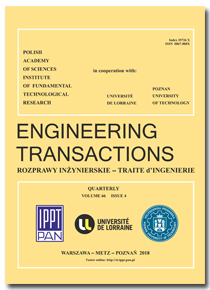10.24423/engtrans.3422.2025
Employing Frequency-Modulated Signals for Tonal Excitation in Airborne Sound Insulation Measurements
To enhance the similarity of acoustic insulation testing conditions in the laboratory, a tonal signal was employed as the excitation signal, reflecting real-world scenarios, such as transformer noise. To mitigate the non-uniformity of the acoustic field associated with tonal excitation, a tonal excitation with frequency modulation (FM) was applied in the experiment.
An experimental verification was first conducted to assess the influence of modulated signal parameters – modulation depth and frequency – on improving the uniformity of sound pressure distribution and reverberation time. Subsequently, acoustic insulation measurements were taken in a set of reverberation chambers using tonal excitation with the experimentally optimized FM modulation parameters. The results were compared with data obtained from measurements using noise excitation and harmonic excitation without modulation.
Preliminary findings indicate that FM signals significantly reduce the non-uniformity of the acoustic field in both chambers compared to tonal signal, as well as the reverberation time in the receiving chamber. Consequently, the quality of acoustic insulation measurements improved with reduced result variability and increased “fidelity” to real-world conditions.
References
ISO 10140-4, Acoustics – Laboratory measurement of sound insulation of building elements – Part 4: Measurement procedures and requirements, 2021.
Hak C.C., van Hout N.H., Martin H.J., Measuring sound insulation using deconvolution techniques, The Journal of the Acoustical Society of America, 123(5_Supplement): 3501–3501, 2008, doi: 10.1121/1.2934378.
Hunt F.V., On frequency modulated signals in reverberation measurements, The Journal of the Acoustical Society of America, 5(2): 127–138, 1933, doi: 10.1121/1.1915640.
Cook R.K., Modulated reverberation – a new method for measurement of absorption and sound power, The Journal of the Acoustical Society of America, 54(1_Supplement): 302, 1973, doi: 10.1121/1.1978180.
Ozimek E., Rutkowski L., Deformation of frequency modulated (FM) signals propagating in a room, Applied Acoustics, 26(3): 217–230, 1989, doi: 10.1016/0003-682X(89)90055-8.
JCGM 100: 2008, Evaluation of measurement data – Guide to the expression of uncertainty in measurement, 2008.
Wszołek T., Uncertainty of sound insulation measurement in laboratory, Archives of Acoustics, 32(4S): 271–277, 2007.
DOI: 10.24423/engtrans.3422.2025





